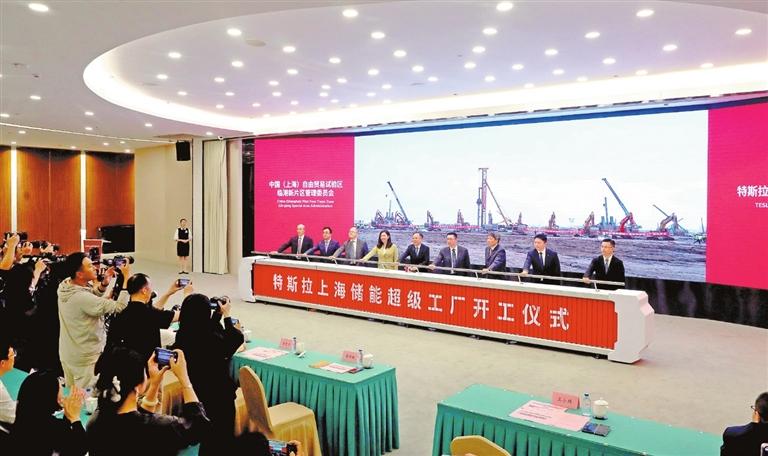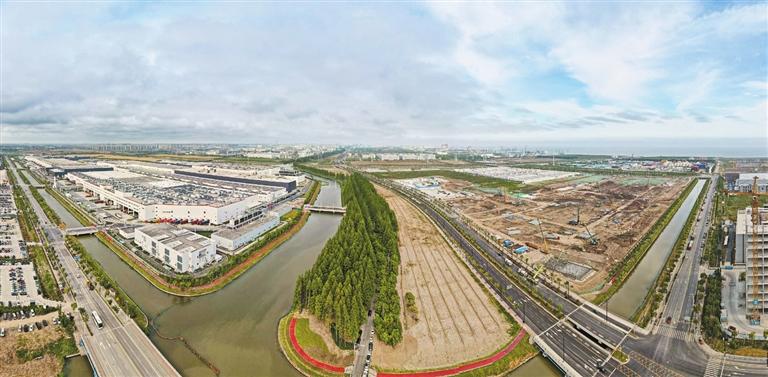


U.S. carmaker Tesla commenced construction of a mega factory in Shanghai on Thursday, to produce Megapack energy storage batteries. The milestone project is slated for mass production in the first quarter of 2025. Tesla’s Megapack is a powerful battery that provides energy storage and support, helping to stabilize the grid and prevent outages, according to details on the company’s website. The Shanghai facility would have the same level of production capacity as Tesla’s Megafactory in Lathrop, California. It will initially produce 10,000 Megapack units every year, equal to nearly 40 gigawatt hours of energy storage. The new plant spans an area of approximately 200,000 square meters, with a total investment of around 1.45 billion yuan (US$203.94 million). It is the first of its kind built by Tesla outside the United States and the company’s second plant in Shanghai, following the inauguration of its Gigafactory in 2019 which involved an initial investment of over 50 billion yuan. The factory is a “potential game changer for Tesla on the battery front,” said Daniel Ives, an analyst at Wedbush Securities. “In this EV (electric vehicle) arms race Tesla is further building its lead in battery technology with the new Megapack factory in China, another flex-the-muscle moment for Musk.” “I believe the new plant is a milestone for both Shanghai and Tesla,” said the Tesla’s vice president Tao Lin, adding that, “in a more open environment, we can create a new Tesla speed at the Megapack factory, and supply the global market with large-scale energy-storage batteries manufactured in China.” Lu Yu, an official of the Lingang Special Area Administration, said: “With Tesla’s benchmark project, we anticipate that within the next three to five years, an industrial cluster centered around energy storage will rapidly emerge.” Following the ceremony, Tesla signed a deal with Shanghai Lingang Economic Development (Group) Co., Ltd., securing the first orders for its Megapacks in China. Gong Wei, vice president of Lingang Group, said the Megapacks would be used for energy storage in a data center in the Lingang Special Area, as part of its efforts to achieve carbon peaking and carbon neutrality. Tesla’s deep involvement in the energy storage industry now rivals its electric vehicles in importance, Tao said, adding that its energy storage products are currently used in over 60 countries and regions. The U.S. company already has a factory for its Megapacks in California, the United States, which has an annual capacity of 10,000 units. Each Megapack unit can store over 3.9 megawatt-hours of energy, sufficient to power approximately 3,600 households for one hour. They are designed for utilities and large-scale commercial projects, not vehicles. “Tesla opening Megapack factory in Shanghai to supplement output of Megapack factory in California,” Elon Musk said on Twitter. As the global renewables powerhouse, China is a major market for energy storage. Last year, its installed renewable energy capacity surpassed thermal power for the first time, accounting for approximately 50% of the global additions to renewable energy capacity. Tesla’s plan to open a Megapack battery plant in Shanghai was announced last April, cementing another foothold for the company in China. The land acquisition deal for the project was signed last December, and it received a construction permit earlier this month. Lauding China’s efforts in developing a new energy industry, including the energy storage sector, Tao said the country boasts complete industrial chains, vast market potential, and a production and business environment crucial for enterprise growth. In January 2019, Tesla broke ground on its Shanghai Gigafactory, becoming the first company to benefit from a policy allowing foreign carmakers to establish wholly-owned subsidiaries in the world’s largest automotive market and one of the fastest-growing EV markets. That facility was built within 10 months, at 65% of the cost of the Model 3 production plant in the United States. Within a few years, it became the biggest EV production plant on the planet. The Shanghai facility is Tesla’s main export hub, supplying vehicles to most markets outside of North America. The Gigafactory delivered 947,000 vehicles in 2023, an increase of 33% from the previous year. More than half of Tesla’s global deliveries of over 1.8 million electric vehicles last year originated from the Shanghai factory. Tesla is also making inroads among Chinese drivers. Last month, the China Passenger Car Association (CPCA) said the company sold 88,869 units of Shanghai-made EVs in March. According to Reuters, that figure was 35% higher than a year ago. Tesla is the second largest EV maker in the country behind market leader BYD (BYDDF), which sold 206,089 units in March. In January, Tesla slashed prices in China for the second time in less than three months, in an effort to boost sales as amid slowing demand in the world’s largest car market. The cuts came days after Beijing ended a 13-year-long subsidy for electric vehicle purchases, a move that is expected to put further pressure on car demand. For 2023, the CPCA estimates sales of new energy cars, which are mostly EVs, to reach 8.5 million units, which will account for 36% of total car sales, according to the official China Securities Journal. Total passenger cars sales in China hit 20.5 million units in 2022, up 1.9% from the year before, the association was quoted as saying. Thursday’s groundbreaking ceremony for the Megapack plant comes less than a month after Tesla CEO Elon Musk visited China when he said the company is willing to deepen cooperation with the country to achieve more win-win results. China’s faster-than-expected economic growth of 5.3% in the first quarter reaffirms its attractiveness for foreign investment. Airbus last month unveiled plans for a second final-assembly line in the north. The number of newly established foreign-invested firms in the country hit 12,000 during the period, up 20.7% year on year. (SD-Agencies) | 
